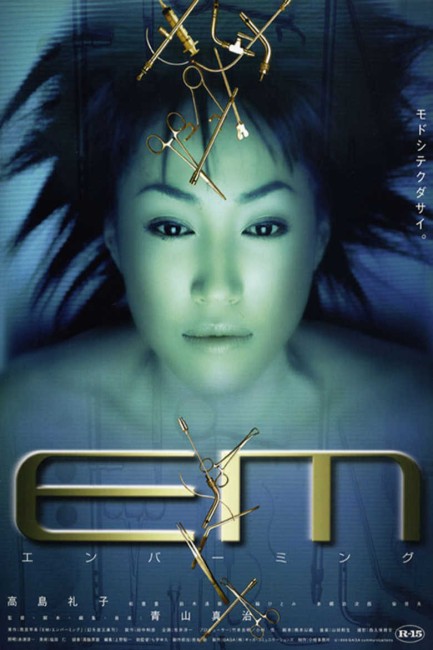(Enbamingu)
Japan. 1999.
Crew
Director – Shinji Aoyama, Screenplay – Shinji Aoyama & Izo Hashimoto, Based on a Story by Saki Amimaya, Producers – Satoru Ogura & Katsuaki Takemoto, Photography – Korehiro Nishikubo, Music – Aoyama & Isao Yamada, Makeup Effects – Akiteru Nakata, Production Design – Jan Shioda & Okutu Tetsuo. Production Company – Gaga Pictures.
Cast
Reiko Takashima (Miyaka Murakami), Yutaka Matsushige (Detective Hiraoka), Toshio Shiba (Dr Fuji), Hitomi Miwa (Rika Shinohara), Kojiro Hongo (Jion Bonze), Masatoshi Matsuo (Yoshiko Shindo/Kuniaki Osato)
Plot
Embalmer Miyaki Murakami is called to treat the body of teenager Yoshiko Shindo, the son of a politician, after he jumps from a rooftop apparently in a suicide. She then receives a warning from Jion Bonze, the priest of the Daitokuin temple, that what she is doing is evil. Immediately after, someone breaks into the embalming parlour and steals Shindo’s head. The police believe it is Shindo’s girlfriend Rika. Miyaki instead follows a lead that takes her to Dr Fuji, a disgraced doctor and embalmer who runs a black market operation selling organs taken from cadavers. This takes Miyaki and a detective into a labyrinthine mystery involving the organ black market, the split-personalitied Rika, Shindo’s twin brother, sinister psychotherapeutic techniques practiced by Jion, the realisation that Shindo might have been murdered and Miyaki’s discovery that the eventual answer holds the truth about mysteries from her own past.
Director/writer Shinji Aoyama has become a promising force in Japanese cinema in the latter half of the 1990s. He began making Yakuza and troubled youth films such as Helpless (1996), Chinpira (1996), An Obsession (1997) and Wild Life (1997), which were often seen as being influenced by Beat Takashi, before growing to acclaim with the relationship drama Shady Grove (1999) and Eureka (2000) about a group of people and their search for the meaning of existence following a bus hijacking.
Embalming was Shinji Aoyama’s venture into the horror genre. Rather than holding any allegiance to contemporaneous Japanese genre horrors like Ring (1998) et al, this is more of a clinical, necrotomic horror in the vein of a film like Anatomie (2000) or the taboo-defying NEKROmantik (1987). Aoyama certainly gets one’s attention in the opening few minutes when he stages a gut-crunchingly realistic embalming. His camera sits impassively on as we see in calmly detached closeup detail as the heroine inserts cotton wool and plastic padding into a head that has been split open, before sewing a flap of skull back on; inserts pieces of metal under the eyelids; jabs a tube into the jugular and starts pumping out the blood – all before the superbly creepy moment where one of the body’s eyelids starts to flicker. Aoyama is not however going for shock effect or the cartoony tongue-in-cheek splatter of films like Re-Animator (1995), Bad Taste (1988) or the later Japanese gonzo splatter cycle of directors like Yoshihiro Nishimura with Tokyo Gore Police (2008) and Vampire Girl vs Frankenstein Girl (2009). This is more grisly real gore, the following of procedure in documentary-like detail.
Certainly, there is no doubt that what we are seeing during the embalming scenes is an authentic depiction of real-life practices. There is another scene later on where heroine Reiko Takashima meets the black market organ-legging doctor (a fine unsentimental performance from Toshio Shiba) in his laboratory in the back of a truck where we see him removing the entrails from a corpse and packaging them in plastic for dispersal, and he then sits back in his filthy charnel house smoking a cigarette while talking to her, before draining the corpse’s blood out into the gutter outside the truck and then severing the head with a chainsaw and tossing it in a trash bucket.
The main problem with Embalming is that Shinji Aoyama creates immensely exciting promise in these scenes – a film that goes way out on a grisly edge with taboo-defying determination and delves into a dark hidden underworld of black-market organ-legging. Alas despite a good start, it is a film that gets sidetracked away into an extraordinarily complicated plot involving:– a girl with multiple personality disorder, twins of the deceased, sinister religious cults, suicide pacts, secret revelations about the heroine’s father’s identity and its relationship to the crimes and even her chosen career as an embalmer, as well as further familial revelations about the parentage of not only the dead teenager but also the split-personalitied girl. It is a thriller plot that seems overburdened by this constant need to keep providing surprise revelations and Aoyama’s determination to wind every single aspect of the film together into an interconnected mandala of associations. Indeed, by the end of the film, what had started as a promisingly grisly horror show about embalming merely ends up as a contorted thriller of credibility defying improbability filled with almost anything that Aoyama has thought to throw into the plot.
Shinji Aoyama subsequently went onto deal with strange cults in A Forest With No Name (2002). Aoyama subsequently returned to genre material with My God, My God, Why Hast Thou Forsaken Me? (2005) about a future affected by a deadly virus.

